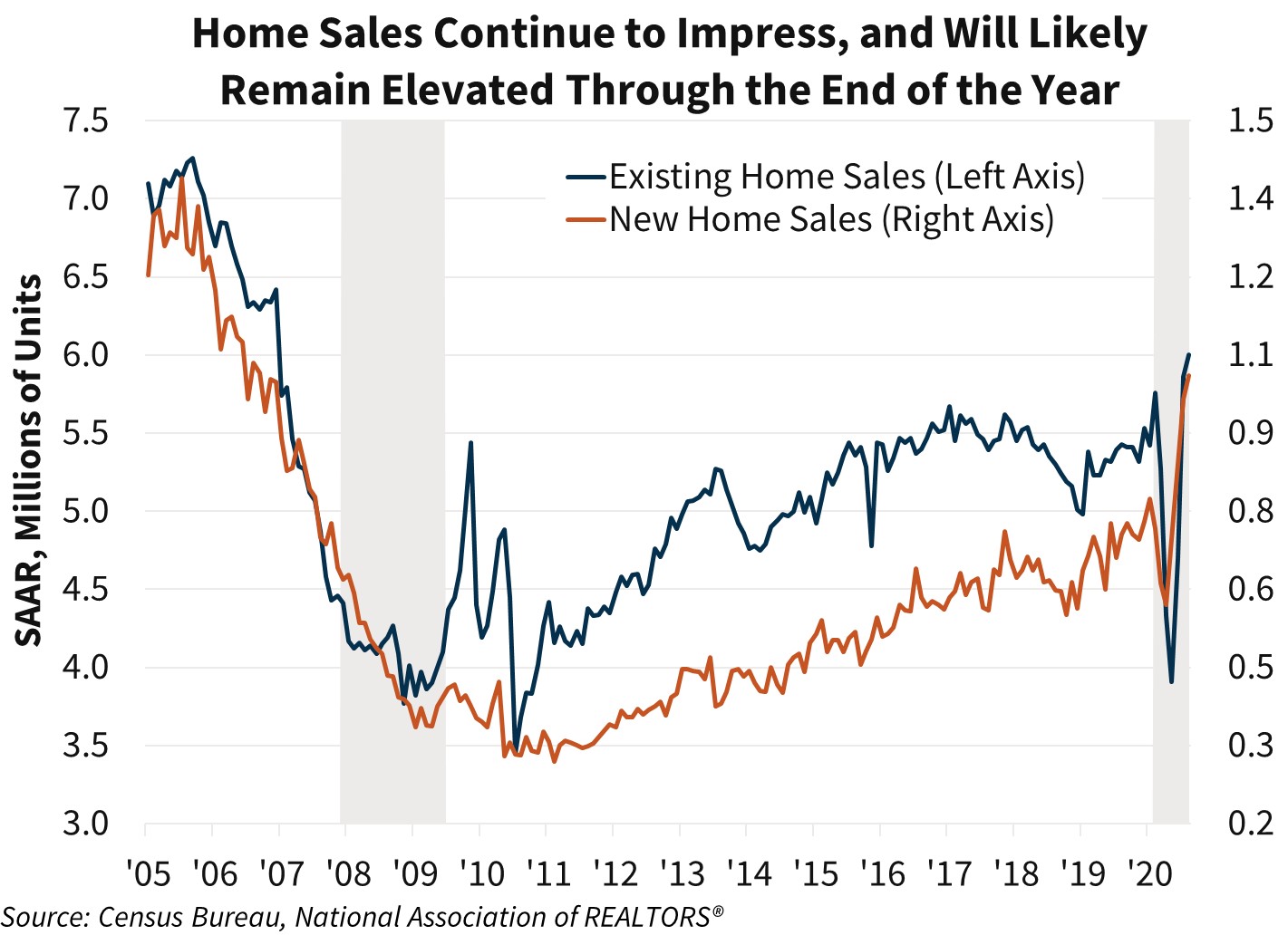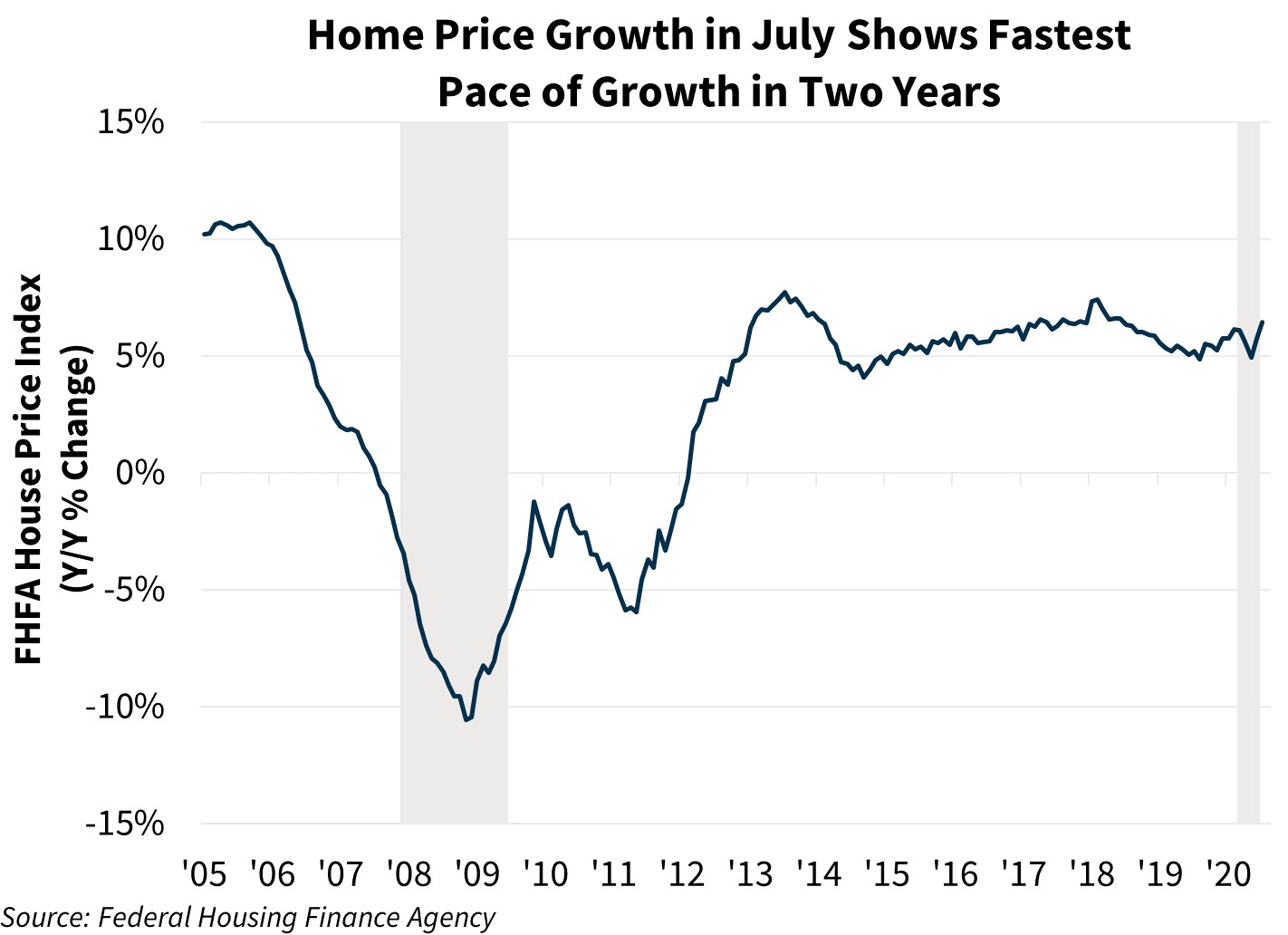Home Sales Impress, Though Inventories Remain at Record Lows
Key Takeaways:
- Durable goods orders edged up 0.4 percent in August, according to the Census Bureau, though orders remained 5.4 percent below the level seen in February. Transportation had no effect on the rate of change of durable goods orders in August. New orders of motor vehicles and parts fell 4.0 percent, the first decline in four months. Total shipments fell 0.3 percent, the first decline since April. Orders for core capital goods (nondefense excluding aircraft) rose 1.8 percent and core shipments increased 1.5 percent.
- Existing home sales continued to impress, rising 2.4 percent in August to a seasonally adjusted annualized rate (SAAR) of 6.0 million units, according to the National Association of REALTORS®. This was the highest level since the end of 2006. Sales rose in every region. However, total sales were still down 2.5 percent year to date compared to the same period a year ago. Sales of single-family homes rose 1.7 percent to a SAAR of 5.4 million, while sales of condos/co-ops rose 8.6 percent to 630,000, with both surpassing the levels seen in February. The number of homes for sale (not seasonally adjusted) fell 18.6 percent year over year, the fifteenth consecutive month of declining inventories. The months’ supply fell one-tenth to 3.0 months, the lowest August reading since the series began in 1999.
- New single-family home sales rose 4.8 percent in August to a SAAR of 1.0 million, according to the Census Bureau, the highest level in almost 14 years. Sales fell in the West and Midwest. Year-to-date sales are now up 14.8 percent from the same period in 2019. The share of homes sold that have yet to be started rose to almost 34 percent of sales, the highest share since late 2017 and up from April’s low of 20 percent. The inventory of new homes for sale continued to decline, falling to the lowest level in three years; the months’ supply fell three-tenths to 3.3, the lowest level since the series began in 1963. From a year ago, the median sale price fell 4.3 percent.
- U.S. household and nonprofit organization net worth—the value of assets minus liabilities—rebounded in the second quarter by the largest one-quarter increase in series history, according to the Federal Reserve. Almost half of the total gain was driven by an increase in corporate equity wealth, which rose by $3.5 trillion, though it still remained 8.3 percent below the peak seen in Q4 2019 (in nominal terms). Net worth was also bolstered by record increases in deposits to checking and savings accounts. Owners’ equity in real estate rose solidly, and owners’ equity in real estate as a percentage of household real estate value increased to 65.6 percent, the highest share since 1990. Single-family mortgage debt outstanding rose to $11.3 trillion (nominal), just below the record high seen in Q1 2008.
- The FHFA Purchase-Only House Price Index, reported on a seasonally adjusted basis, rose 1.0 percent in July. From a year ago, the index rose 6.4 percent, an acceleration of seven-tenths from last month, and the fastest annual pace of growth in two years.
- Mortgage applications rose 6.8 percent for the week ending September 18, according to the Mortgage Bankers Association. Purchase applications rose by 3.4 percent and refinance applications rose 8.8 percent.
Forecast Impact:
The increase in orders for core capital goods supports our expectations of a rebound in business fixed investment in the third quarter as the economy continued to reopen. The record increase in household and nonprofit net worth in the second quarter also supports our expectation of a substantial rebound in growth in the third quarter, particularly given the record increases in both checking and savings deposits, which we believe should help fuel consumer spending. In housing, data released this week showed impressive resiliency as the housing market continued its “V-shaped” recovery, with total home sales rising to the highest level in 14 years. We believe sales are being propelled by the low mortgage rate environment, along with a shift of the spring buying season into later in the year given the COVID-19 disruption. The increase in purchase applications to the highest level since early 2009 suggests further strength in sales heading into the fourth quarter. Given the greater-than-expected increase in sales along with the previously reported increase in housing starts, we will likely further upgrade our forecast for new home sales and construction for the remainder of the year. While we do expect construction to rise, inventories remain near or at record lows, constraining the amount by which sales can increase. Additionally, we believe rising uncertainty around fiscal and other government policies could erode consumer confidence, which could weigh on the pace of sales.


Economic and Strategic Research Group
September 25, 2020
Opinions, analyses, estimates, forecasts and other views of Fannie Mae's Economic and Strategic Research (ESR) Group included in these materials should not be construed as indicating Fannie Mae's business prospects or expected results, are based on a number of assumptions, and are subject to change without notice. How this information affects Fannie Mae will depend on many factors. Although the ESR group bases its opinions, analyses, estimates, forecasts and other views on information it considers reliable, it does not guarantee that the information provided in these materials is accurate, current or suitable for any particular purpose. Changes in the assumptions or the information underlying these views, including assumptions about the duration and magnitude of shutdowns and social distancing, could produce materially different results. The analyses, opinions, estimates, forecasts and other views published by the ESR group represent the views of that group as of the date indicated and do not necessarily represent the views of Fannie Mae or its management.
